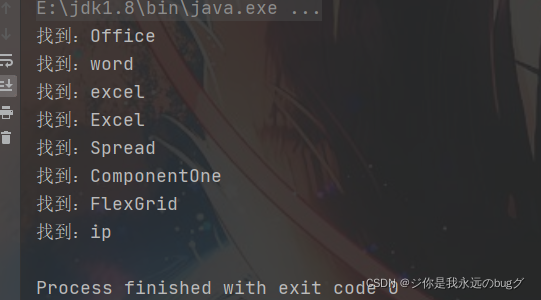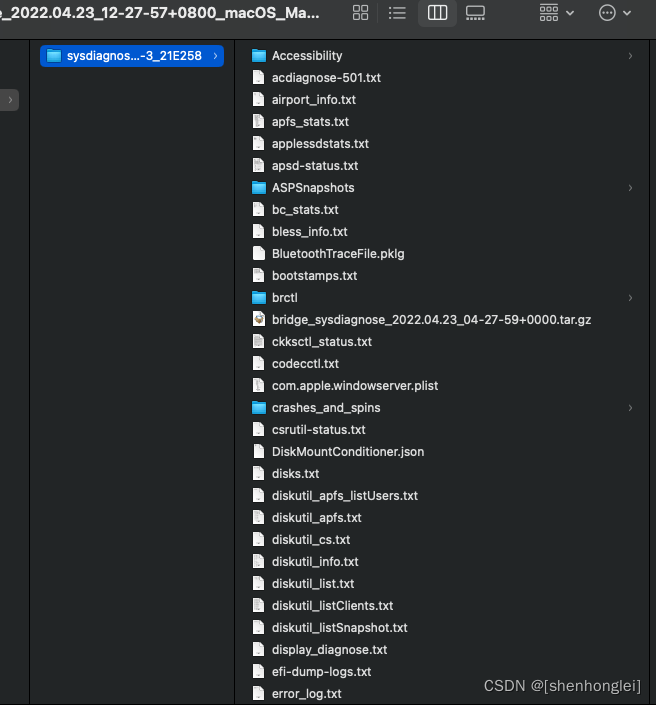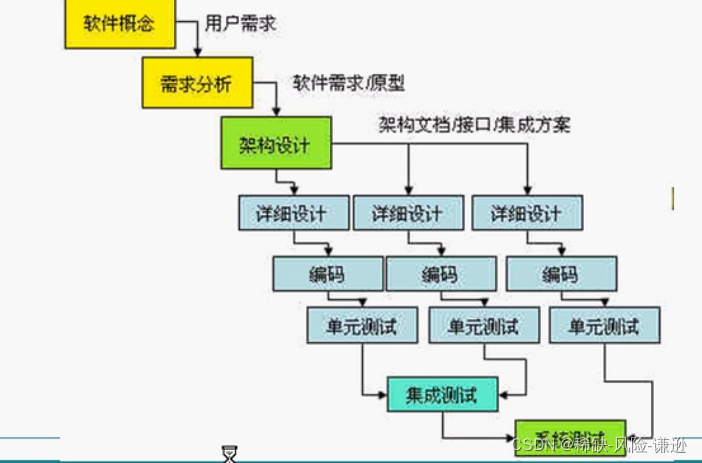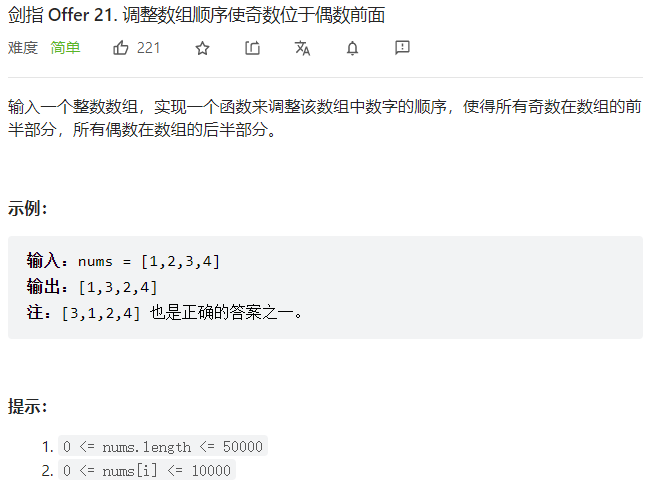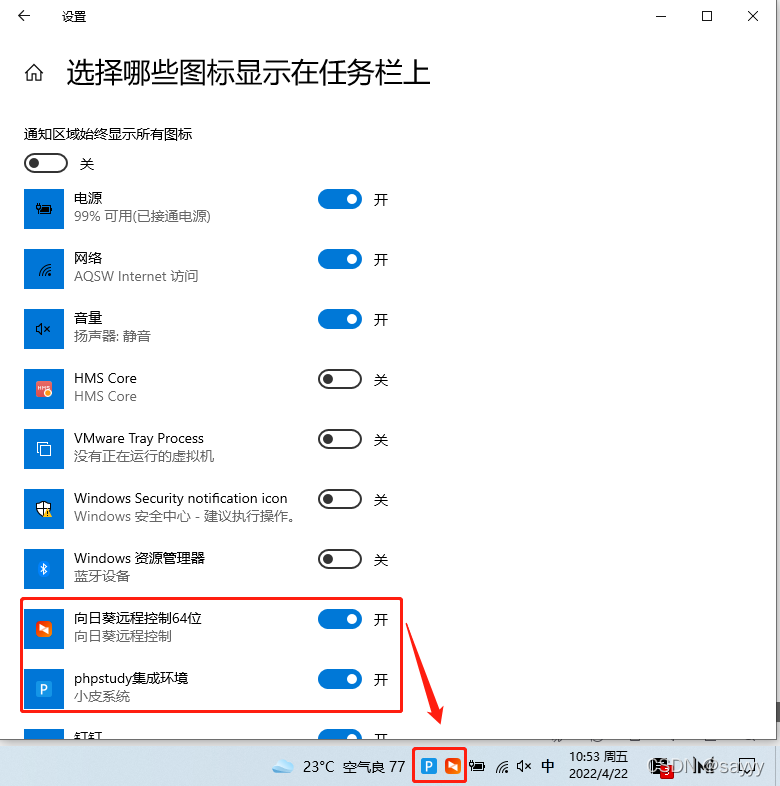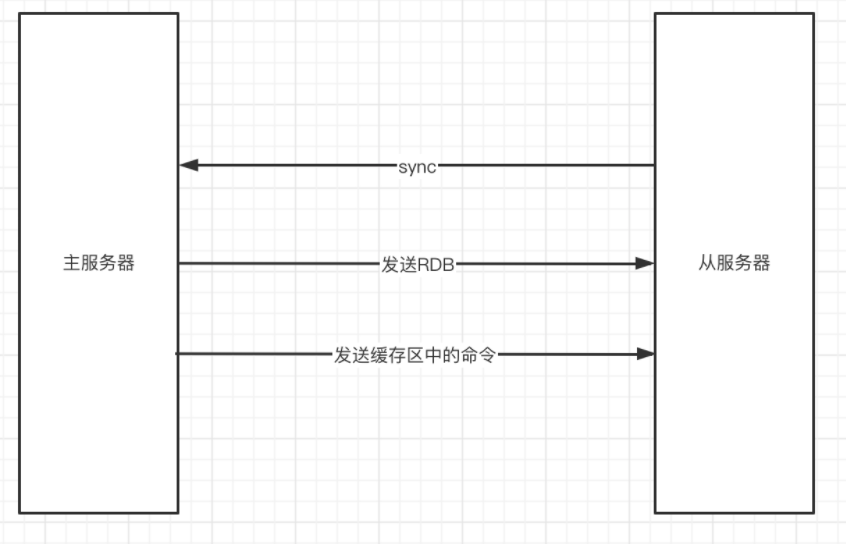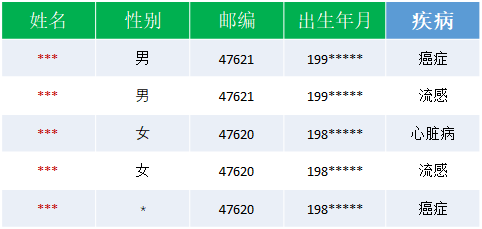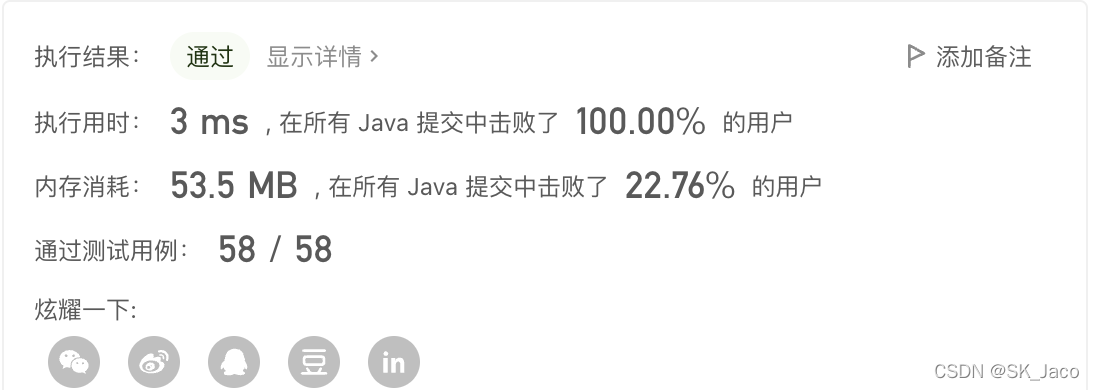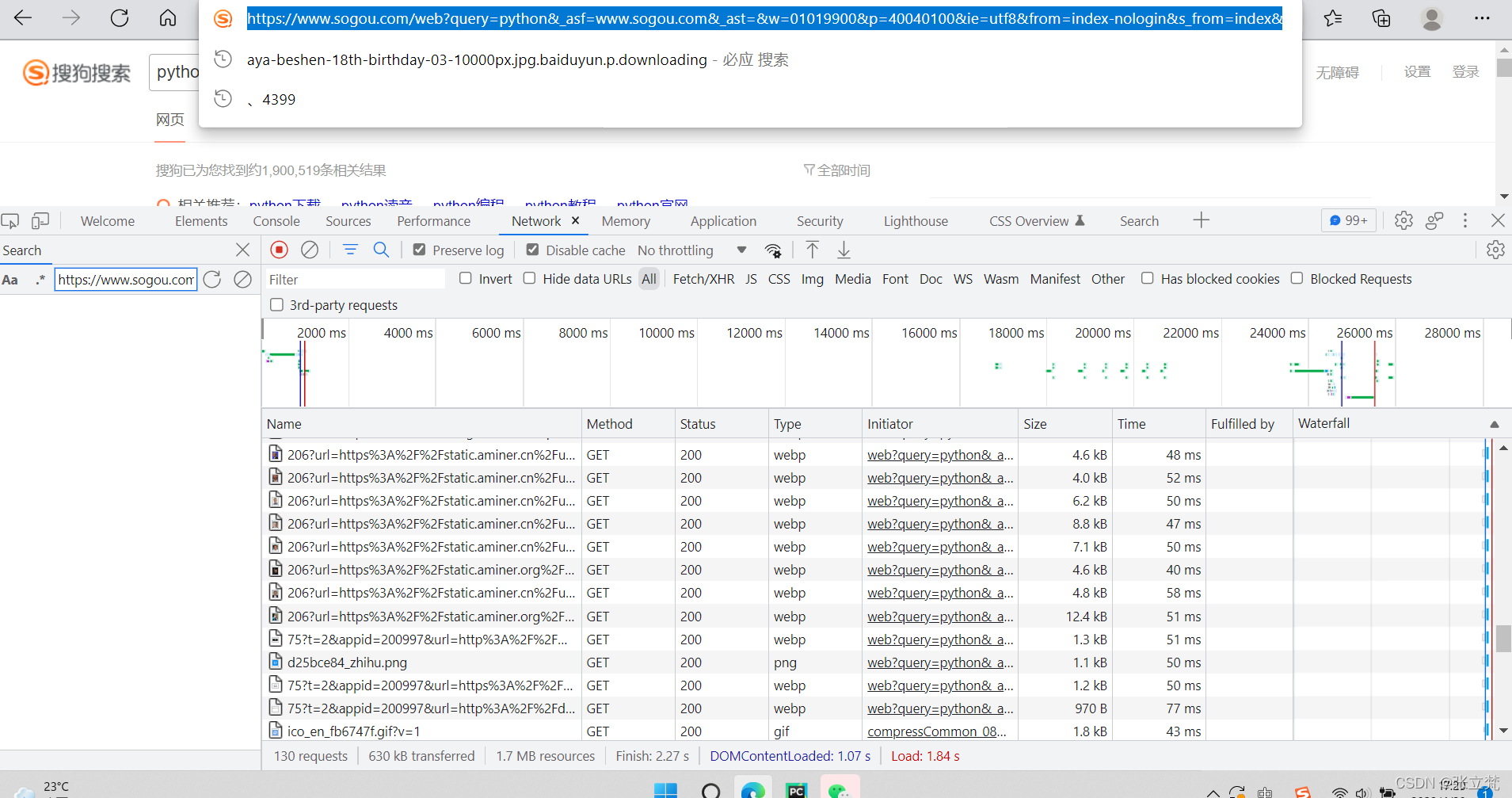当前位置:网站首页>regular expression
regular expression
2022-04-23 15:15:00 【You are my bug forever】
1、 feel The charm of regular expressions
1.1、 Regular expression steps
- So let's create one Pattern object , Pattern object , Is a regular expression object
Pattern pattern = Pattern.compile("[a-zA-z]+");
- Create a matcher object : Namely matcher The matcher follows pattern To content Take the matching that meets the requirements in the text
Matcher matcher = pattern.matcher(content);
- Start the loop matching
while (matcher.find()){
// Match content . Put it in matcher.group(0)
System.out.println(" find :" + matcher.group(0));
}
1.2、 Example
/** * Experience the power of regular expressions , Ask us what convenience it brings to our processing * * Regular expressions deal specifically with text classes */
public class A_regexp {
public static void main(String[] args) {
// as follows Text
String content = " Order software is generally used to display numbers and other items for quick reference and analysis ." +
" in real life : Order software has form application software and form control ," +
" A typical image Office word,excel The form is 1 Most commonly used order data 8 One way to manage ," +
" The main 6 For input 、 Output 、 Show 、 Process and print data , It can make all kinds of complex forms and documents ," +
" Can even help with 5 Users carry out complex 6 Statistical operations and charts 32 It's a show 1 etc. . Table controls also 4 It can be often used in database 1 Presentation and editing of data " +
" Data entry interface design 、 Data exchange ( Such as and Excel Exchange data )、 Data report and distribution, etc . such as Spread ComponentOne Of FlexGrid." +
"ip:172.16.20.20;192.16.255.185";
// Extract all English words in the article
// 1、 traditional method , Traverse A lot of code , The efficiency is not high
// 2、 Use regular expression techniques to match words
// 1、 So let's create one Pattern object , Pattern object , Is a regular expression object
// Pattern pattern = Pattern.compile("[a-zA-z]+"); // Match English words
// Pattern pattern = Pattern.compile("[0-9]+"); // Match the Numbers
// Pattern pattern = Pattern.compile("([0-9]+)|([a-zA-z]+)"); // Match the Numbers + English words
Pattern pattern = Pattern.compile("\\d+\\.\\d+\\.\\d+\\.\\d+"); //ip Address
// 2、 Create a matcher object : Namely matcher The matcher follows pattern To content Take the matching that meets the requirements in the text
Matcher matcher = pattern.matcher(content);
// 3、 Start the loop matching
while (matcher.find()){
// Match content . Put it in matcher.group(0)
System.out.println(" find :" + matcher.group(0));
}
}
}
Sample results : Match English words
2、 The underlying principle of regular expressions
What is regular expression grouping
(\d\d)(\d\d)
Regular expression grouping : first () It's the first group The second is the second group
2.1、 Regular expressions are not grouped
/** * The principle of regular expressions : Underlying implementation * demo: Get... In text Continuous 4 A digital :1998 */
public class B_RegTheory {
public static void main(String[] args) {
String content = "1998 year 12 month 8 Japan , Second generation Java Enterprise version of the platform J2EE Release .1999 year 6 month ," +
"Sun The company released a second generation Java platform ( Referred to as Java2) Of 3 A version :J2ME(Java2 Micro Edition,Java2 A miniature version of the platform )," +
" Apply to move 、 Wireless and limited resource environment ;J2SE(Java 2 Standard Edition,Java 2 The standard version of the platform )," +
" For desktop environments ;J2EE(Java 2Enterprise Edition,Java 2 Enterprise version of the platform ), Apply to based on Java Application server .Java 2 Platform release ," +
" yes Java The most important milestone in the development process , Mark the Java Application start 1991 Universal .\n" +
"1999 year 4 month 27 Japan ,HotSpot Virtual machine Publishing .HotSpot The virtual machine sends 2992 Cloth is used as JDK 1.2 Additional procedures for 3993 Provided ," +
" Then it became JDK 1.3 And 12345678 All versions after Sun JDK The default virtual machine for ";
/** * Get... In text Continuous 4 A digital : Such as 1998 * * explain : * 1、\\d Represents an arbitrary number * */
String regStr = "\\d\\d\\d\\d";
// So let's create one Pattern object , Pattern object , Is a regular expression object
Pattern pattern = Pattern.compile(regStr);
// 2、 Create a matcher object : Namely matcher The matcher follows pattern To content Take the matching that meets the requirements in the text
Matcher matcher = pattern.matcher(content);
// 3、 Start the loop matching
while (matcher.find()){
// Match content . Put it in matcher.group(0)
System.out.println(" find :" + matcher.group(0));
}
}
}
2.1.1 matcher.find() effect
1、 Locate the substring that satisfies the rule according to the specified rule ( such as 1998)
2、 After finding , Record the start index of the substring to matcher In the properties of the object int[] groups;
such as 1998 in 1 The index of is 0 groups[0] = 0
End character 8 The index of +1 The value of is recorded in groups[1] = 4
3、 Simultaneous recording oldLast The value of is Match end character The index of +1 Next time find Start here
Take a break and see :groups The default value is -1
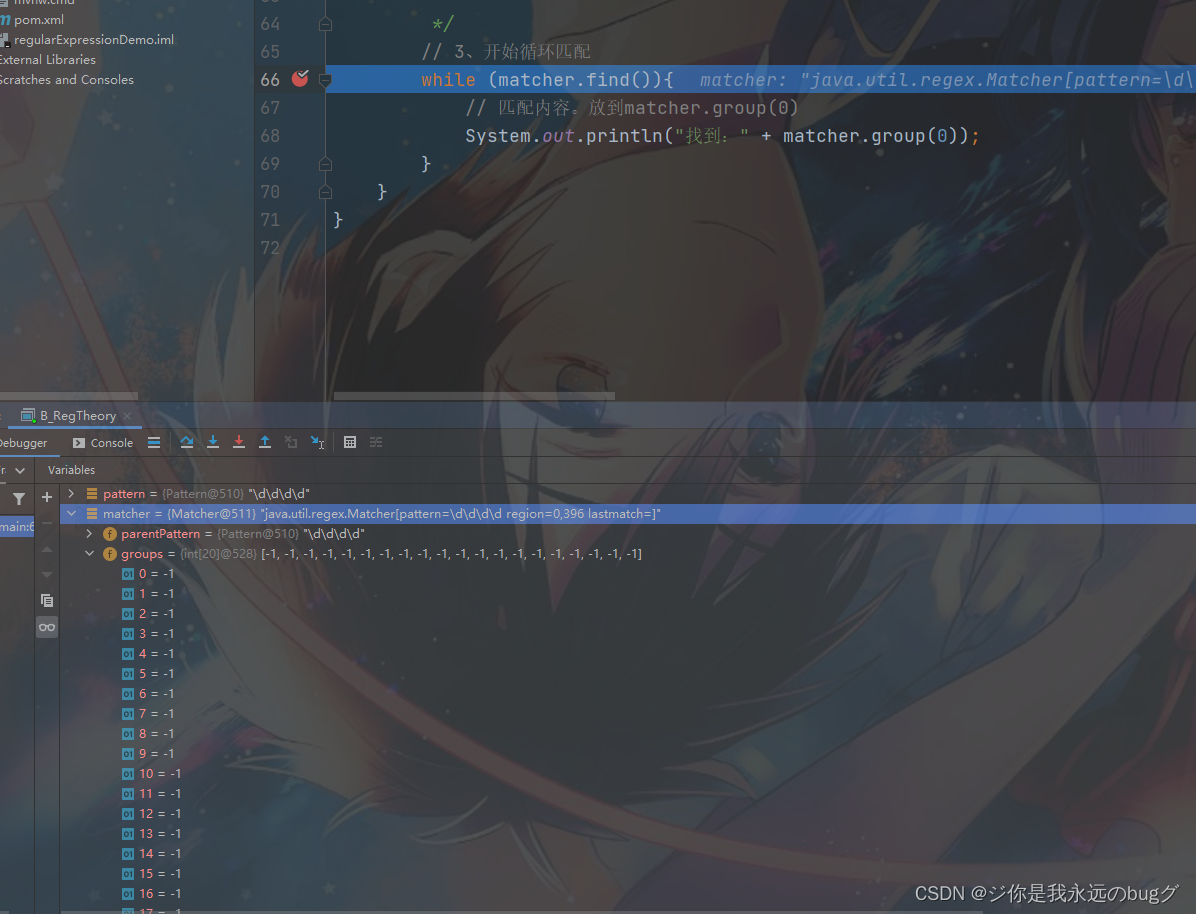
Break point next groups[0] = 0 groups[1] = 4
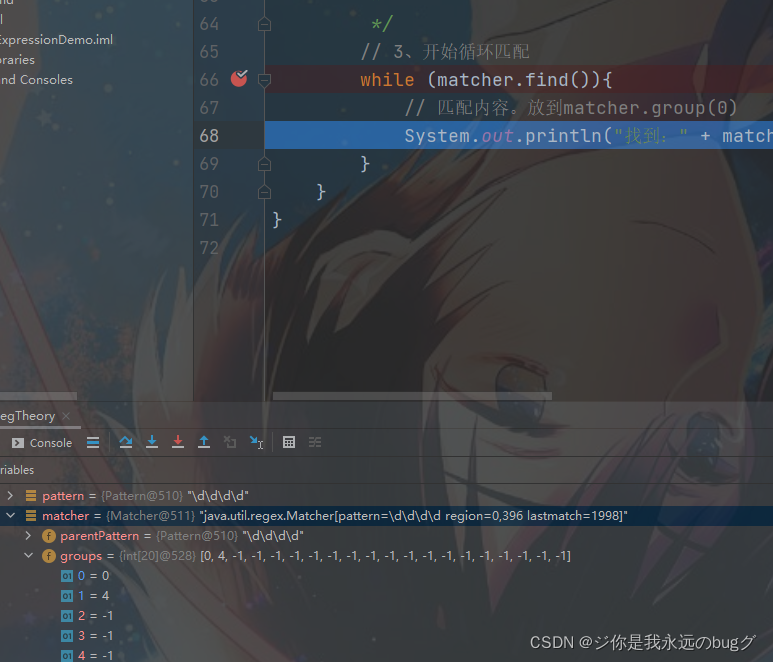
meanwhile oldLast = 4 The next time from 4 Start matching
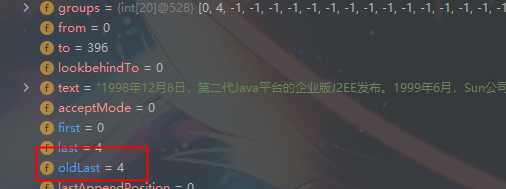
2.1.2、matcher.group(0) effect
Source code :
public String group(int group) {
if (first < 0)
throw new IllegalStateException("No match found");
if (group < 0 || group > groupCount())
throw new IndexOutOfBoundsException("No group " + group);
if ((groups[group*2] == -1) || (groups[group*2+1] == -1))
return null;
return getSubSequence(groups[group * 2], groups[group * 2 + 1]).toString();
}
according to group[0] = 0 and group[1] = 4 The location of the record , from content Start to intercept the substring and return
Namely from String In text subString(0,4) Print out Rule compliant text
2.2、 Regular expression grouping
String regStr = “(\d\d)(\d\d)”;
/** * The principle of regular expressions : Underlying implementation * demo: Get... In text Continuous 4 A digital :1998 Regular expression grouping */
public class C_RegTheory {
public static void main(String[] args) {
String content = "1998 year 12 month 8 Japan , Second generation Java Enterprise version of the platform J2EE Release .1999 year 6 month ," +
"Sun The company released a second generation Java platform ( Referred to as Java2) Of 3 A version :J2ME(Java2 Micro Edition,Java2 A miniature version of the platform )," +
" Apply to move 、 Wireless and limited resource environment ;J2SE(Java 2 Standard Edition,Java 2 The standard version of the platform )," +
" For desktop environments ;J2EE(Java 2Enterprise Edition,Java 2 Enterprise version of the platform ), Apply to based on Java Application server .Java 2 Platform release ," +
" yes Java The most important milestone in the development process , Mark the Java Application start 1991 Universal .\n" +
"1999 year 4 month 27 Japan ,HotSpot Virtual machine Publishing .HotSpot The virtual machine sends 2992 Cloth is used as JDK 1.2 Additional procedures for 3993 Provided ," +
" Then it became JDK 1.3 And 12345678 All versions after Sun JDK The default virtual machine for ";
/** * Get... In text Continuous 4 A digital : Such as 1998 * * explain : * 1、\\d Represents an arbitrary number * * Regular expressions There is one () It's a group. Two are two groups * */
String regStr = "(\\d\\d)(\\d\\d)";
// So let's create one Pattern object , Pattern object , Is a regular expression object
Pattern pattern = Pattern.compile(regStr);
// 2、 Create a matcher object : Namely matcher The matcher follows pattern To content Take the matching that meets the requirements in the text
Matcher matcher = pattern.matcher(content);
// 3、 Start the loop matching
while (matcher.find()){
// Match content . Put it in matcher.group(0)
System.out.println(" find :" + matcher.group(0));
System.out.println(" Find the first group :" + matcher.group(1));
System.out.println(" Find the second group :" + matcher.group(2));
}
}
}
The biggest difference between groups is matcher.find():
1、 Locate the substring that satisfies the rule according to the specified rule ( such as 1998)
2、 After finding , Record the start index of the substring to matcher In the properties of the object int[] groups;
such as 1998 in
2.1、 1 The index of is 0 groups[0] = 0 End character 8 The index of +1 The value of is recorded in groups[1] = 4
2.2、 Record the first group Matching string 19 groups[2] = 0, End character 9 The index of +1 :groups[3] = 2
2.3、 Record the second group Matching string 98 groups[4] = 2, End character 8 The index of +1 :groups[5] = 4
And so on
3、 Simultaneous recording oldLast The value of is Match end character The index of +1 Next time find Start here
Take a look at

At this time You can print Regular expressions Each group is matched to character string
// 3、 Start the loop matching
while (matcher.find()){
// Match content . Put it in matcher.group(0)
System.out.println(" find :" + matcher.group(0));
System.out.println(" Find the first group :" + matcher.group(1));
System.out.println(" Find the second group :" + matcher.group(2));
}
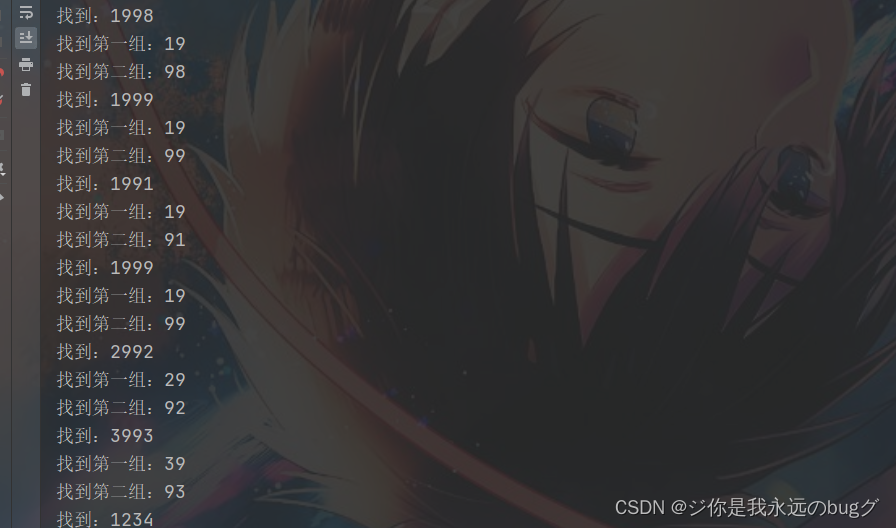
3、 Metacharacters
3.1、 Escape number
Transfer number :\
Tips :java Two of them \\ amount to In other languages One \
explain : When retrieving some special characters with regular expressions , You need an escape symbol \\ Otherwise, the result cannot be retrieved Even reported a mistake
Case study : use $ To match “abc$(”
public class D_Regexp {
public static void main(String[] args) {
String str = "abc$(abc(123(";
String regStr = "\\$";
Pattern compile = Pattern.compile(regStr);
Matcher matcher = compile.matcher(str);
while (matcher.find()){
System.out.println(" find :" + matcher.group(0));
}
}
}
Only add \\ To retrieve Special characters
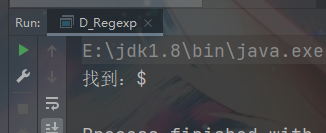
3.2、 Character matchers
| Character matchers | explain | Example | example | In conformity with the requirements demo |
|---|---|---|---|---|
| [] | List of matching characters | [efgh] | matching e、f、g、h Any one of | e |
| [^] | List of unmatched characters | [^edgh] | Match except [] Medium edgh Any other | a |
| - | Connector | [a-z] | matching a-z Any lowercase letter in | a |
| . | Matching elimination \n Any character other than | a…b | With a start With b ending Include two arbitrary characters in the middle, with a length of 4 String | aaab |
| \\d | Match a single numeric character == [0-9] | \\d{3}(\\d)? | Matching continuity 3 individual Or a string of four numbers | abc123 |
| \\D | Match a single non numeric character amount to [^0-9] | \\D(\\d)* | Start with a single non number , Followed by any number string | a12354 |
| \\w | Match a single number 、 Upper and lower case alphabetic characters and underscores == [0-9a-zA-z_] | \\d{3}\\w{4} | Three numbers followed by 4 A digital / Uppercase and lowercase characters /_ | 123as1_ |
| \\W | Match a single non Numbers 、 Upper and lower case alphabetic characters and underscores == [^0-9a-zA-z_] | \\W+\\d{2} | At least one Not Numbers 、 Uppercase and lowercase characters Followed by 2 A string ending in a number | #$23 |
| \\s | Matches any whitespace characters ( Space 、 Box drawings, etc ) | \\s | c v | |
| \\S | Matches any non-whitespace characters ( Space 、 Box drawings, etc ) |
understand :
1、\\d{3} == \\d\\d\\d
2、(\\d)? == \\d There may or may not be
3、(\\d)* == There are any \\d
4、\\W+ == At least one \\W
5、[^a-z]{2} == Two in a row are not a-z The characters of
Case insensitive
Case insensitive
1、(?i)q (?i) The following ones are case insensitive
(?i)acb abc It's not size sensitive
a(?i)bc bc It's not size sensitive
a((?i)b)c b It's not size sensitive
2、Pattern compile = Pattern.compile(regStr,Pattern.CASE_INSENSITIVE);
3.3 Choose the match
|
: matching “ | ” Expressions before or after
Such as :ab|cd :ab perhaps cd
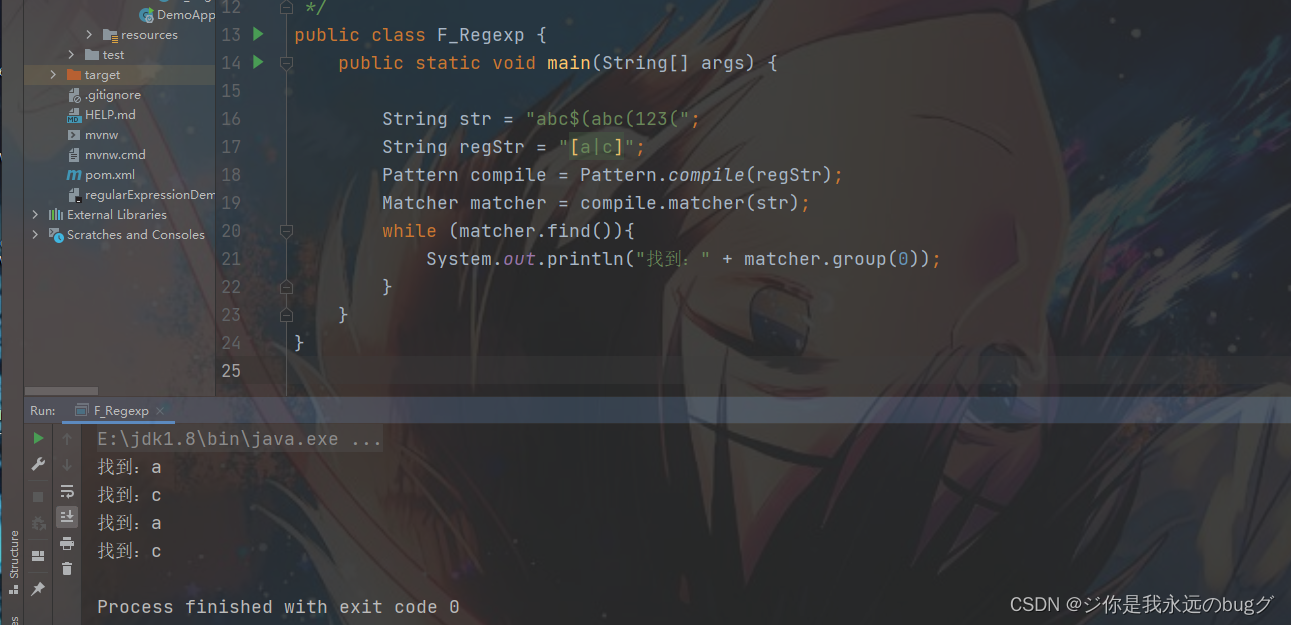
3.4、 qualifiers
Specifies how many consecutive occurrences of characters and combinations that precede them
| qualifiers | explain | Example | example | In conformity with the requirements demo |
|---|---|---|---|---|
| * | Appoint The character appears 0 Time or n Time | (abc)* | Only any abc String | abcabcabc |
| + | The specified character appears at least 1 Time | m+ | At least one m Starting string | mmss |
| ? | The specified character is repeated 0 Time or 1 Time | cm? | c Back Yes 0 individual m perhaps 1 individual m | cmab c |
| {n} | Specifies the number of characters that appear n frequency | [a-z]{3} | a-z There are a total of characters between 3 Time | abc |
| {n,} | The specified character appears at least n frequency | [a-z]{3,} | a-z Characters between at least 3 Time | asfv |
| {n,m} | The specified character appears at least N Time most m Time | [a-z]{3,4} | a-z Characters between appear at least 3 Time most 4 Time | abc |
| ? | Any qualifier follows ?, The matching pattern is changed to Non greedy model | o+? | It was o At least once , add ? It can only be once | aa0 |
understand :
java Try to match as many Default Greedy matching
What is greedy matching
Such as :b{3,4} Text is "bbbbb" here b Yes 5 individual Regular expressions will Match to 4 individual bbbb, As many matches as possible
Non greedy matching :o+? o+ It was at least once , Now add ? It's a non greedy match , Only matches appear 1 individual o
1、ab{3,4} a Followed by 3 A or 4 individual b
2、[ab]{3,4} a perhaps b Three or four consecutive
3、(ab){3,4} ab Three or four consecutive
4、cm? c Back Yes 0 individual m perhaps 1 individual m
.cm? Limited to ? The first character
3.5、 Fixed character
Specify where characters appear , For example, where to start and end
| qualifiers | explain | Example | example | In conformity with the requirements demo |
|---|---|---|---|---|
| ^ | Specify the starting character | ^a | With a start | abc |
| $ | Specify the end character | [a-z]+$ | At least one lowercase letter ends | 1-ss |
| \\b | Match the boundary of the target string | han\\b | The string is divided into substrings with spaces , Substring with han At the end of the | aaa nnhan mmm |
| \\B | Matches the boundary of the non target string | han\\B | The string is divided into substrings with spaces , Substrings are not represented by han At the end of the | aaa hannn mmm |
3.6、 grouping
3.6.1、 Capture grouping
1、 Unnamed capture (pattern)
Capture matching substrings . The number is 0 Of (group(0)) What is captured is the whole regular expression matching ;
Other capture results Is grouped according to () From left to right 1 Numbered starting (group(1)group(2)).
Example :
String str = "asdvxs s7788 nn7785bb";
/** * Unnamed grouping :() It's a group. * group(0)) What is captured is the whole regular expression matching * group(1) The catch is The first group * group(2) The catch is The second group * */
String reg = "(\\d\\d)(\\d\\d)";
Pattern compile = Pattern.compile(reg);
Matcher matcher = compile.matcher(str);
while (matcher.find()){
System.out.println(" find :" + matcher.group(0));
/** * Unnamed grouping */
System.out.println(" find 1:" + matcher.group(1));
System.out.println(" find 2:" + matcher.group(2));
}
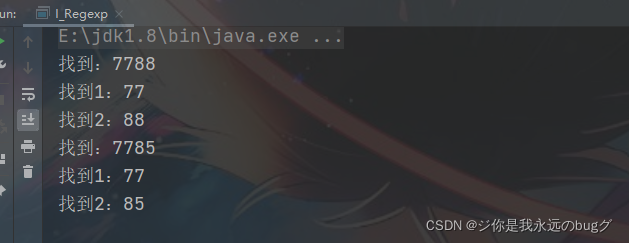
2、 Name groups (?<name>pattern)
Name capture , Capture the matching substring into a group name or number name , You can use numbers or Group name Get the matching content
name The string of cannot contain any punctuation , And can't start with a number , You can use single quotation marks instead of angle brackets , for example :(?‘name’) Example :
String str = "asdvxs s7788 nn7785bb";
/** * * Name groups * */
String reg = "(?<d1>\\d\\d)(?<d2>\\d\\d)";
Pattern compile = Pattern.compile(reg);
Matcher matcher = compile.matcher(str);
while (matcher.find()){
System.out.println(" find :" + matcher.group(0));
/** * Name groups */
System.out.println(" find 1:" + matcher.group("d1"));
System.out.println(" find 2:" + matcher.group("d2"));
}
Is to name the group , Take the matching content with the name
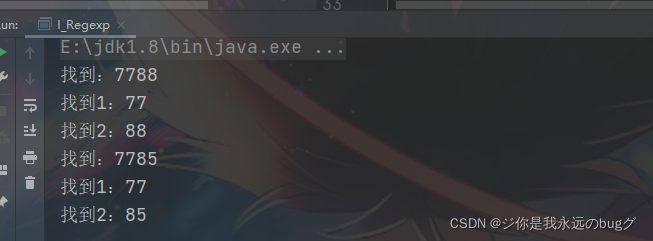
3.6.2、 Non capture grouping
Not Capture groups , Can't be based on group() Get the matching content .
1、(?:pattern)
matching pattern But don't capture the Matching subexpressions , That is, he is
effect : Li (?: Dan | double ) == Li Dan | Li Shuang
Example :
/** * (?:pattern) */
String str = " Li Dan Li Shuang ";
// String regStr = " Li Dan | Li Shuang ";
String regStr = " Li (?: Dan | double )";
Pattern compile = Pattern.compile(regStr);
Matcher matcher = compile.matcher(str);
while (matcher.find()){
System.out.println(" find :" + matcher.group(0));
}
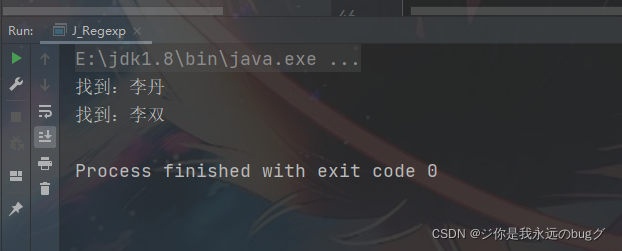
2、(?=pattern)
Non capture match effect :iPhone(?=5|6|8|13) matching iPhone After is 5 perhaps 6 perhaps 8 perhaps 13 Of iPhone character string But it doesn't match iPhone After is 7 Of iPhone character string
/** * (?=pattern) */
String str = "iPhone5,iPhone6,iPhone8,iPhone13,iPhone20";
// String regStr = " Li Dan | Li Shuang ";
String regStr = "iPhone(?=5|6|8|13)";
Pattern compile = Pattern.compile(regStr);
Matcher matcher = compile.matcher(str);
while (matcher.find()){
System.out.println(" find :" + matcher.group(0));
}

3、(?=pattern)
Non capture match effect :iPhone(?!5|6|8|13) Except for a mismatch iPhone After is 5 perhaps 6 perhaps 8 perhaps 13 Of iPhone character string , Everything else matches
/** * (?=pattern) */
String str = "iPhone5,iPhone6,iPhone8,iPhone13,iPhone20";
// String regStr = " Li Dan | Li Shuang ";
String regStr = "iPhone(?!15|6|8|13)";
Pattern compile = Pattern.compile(regStr);
Matcher matcher = compile.matcher(str);
while (matcher.find()){
System.out.println(" find :" + matcher.group(0));
}
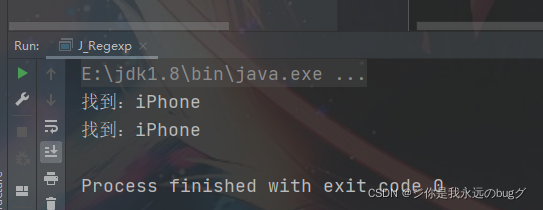
4、 backreferences
Back reference requires Group and capture
1、 grouping : Use one () Form a group
2、 Capture obtain A substring for grouping matching May by group(1)group(2)… obtain
3、 backreferences
After the content of the group is captured , Can be used after this bracket . Then write a more practical matching pattern , We call this backreferences
This reference can be used both in Inside regular expressions use \\ Group number It can also be outside the regular expression , use $ Group number
4.1 Match two consecutive identical numbers
/** * Match two consecutive identical numbers Internal references * */
String str = "12312216543663789";
String regStr = "(\\d)\\1";
Pattern compile = Pattern.compile(regStr);
Matcher matcher = compile.matcher(str);
while (matcher.find()){
System.out.println(" find :" + matcher.group(0));
}

4.2 Match five consecutive identical numbers
/** * Match five consecutive identical numbers Internal references * */
String str = "12312216543666663789";
String regStr = "(\\d)\\1{4}";
Pattern compile = Pattern.compile(regStr);
Matcher matcher = compile.matcher(str);
while (matcher.find()){
System.out.println(" find :" + matcher.group(0));
}
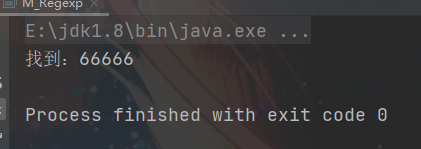
4.3 Find the format :1221 3663 Numbers
/** * requirement Find the four numbers connected together also The first and fourth places are the same The second and third places are the same Such as 1221 3663 */
String str = "12312216543663789";
String regStr = "(\\d)(\\d)\\2\\1";
Pattern compile = Pattern.compile(regStr);
Matcher matcher = compile.matcher(str);
while (matcher.find()){
System.out.println(" find :" + matcher.group(0));
}
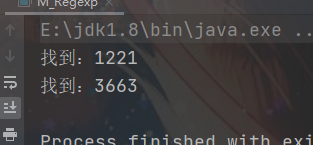
4.4、 find similar :12321-444999666
/** * find similar :12321-444999666 */
String str = "12312212321-44499966663789";
String regStr = "(\\d)(\\d)(\\d)\\2\\1-(\\d)\\4{2}(\\d)\\5{2}(\\d)\\6{2}";
Pattern compile = Pattern.compile(regStr);
Matcher matcher = compile.matcher(str);
while (matcher.find()){
System.out.println(" find :" + matcher.group(0));
}

5、 stammer duplicate removal
Such as : I … I want to go … Learn to learn …java == I'm going to learn java
String str = " I ... I want to go ... Learn to learn ...java";
// 1、 Take out a little bit .
Pattern compile = Pattern.compile("\\.");
Matcher matcher = compile.matcher(str);
str = matcher.replaceAll("");
System.out.println(str);
/** * 2、 Remove the duplicate words * Ideas : 1、 use backreferences Get the duplicate words (.)\\1+ * 2、 Use External reverse reference $1 Replace matching content */
compile = Pattern.compile("(.)\\1+"); // The captured content of the group is recorded to $1
matcher = compile.matcher(str);
while (matcher.find()){
System.out.println(" find :" + matcher.group(0));
}
// Use External reverse reference $1 Replace matching content use I Replace me, i
str =matcher.replaceAll("$1");
System.out.println(str);
6、String class Using regular expressions
String.matches() It's a whole match
public static void main(String[] args) {
String content = "1998 year 12 month 8 Japan , Second generation Java Enterprise version of the platform J2EE Release .JDK1.3 and JDK1.4 and J2SE1.3 One after another ";
// Using regular expressions take JDK1.3 JDK1.4 Replace with JDK
content = content.replaceAll("JDK1.3|JDK1.4", "JDK");
System.out.println(content);
// requirement : Verify a mobile number , The requirement must be 138 139 start
content = "13816966686";
boolean matches = content.matches("^(138|139)\\d{8}");
System.out.println(matches);
// The requirements are as follows # perhaps - perhaps ~ perhaps Numbers To segment
content = "nihao#mawoshi-nidie~shima18suila";
String[] split = content.split("[\\#\\-\\~\\d]");
for (Object d:split) {
System.out.println(d);
}
}
end Test
1、 Verify that the mailbox is legal
/** * 1、 Verify that the mailbox is legal * The rules : * 1、 There can only be one @ * 2、@ The previous is the user name It can be a-zA-Z0-9 and -_ character * 3、@ Followed by the domain name , And the domain name can only be English letters , Such as :sohu.com */
String str = "[email protected]";
String regStr = "^[a-zA-Z0-9\\-\\_]+@([a-zA-Z]+\\.)+[a-zA-Z]+$";
if (str.matches(regStr)){
System.out.println("1ok");
}
2、 Verify whether it is an integer perhaps decimal
/** * 2、 Verify whether it is an integer perhaps decimal * Consider positive numbers and negative * such as :123 -123 34.89 -87.3 -0.01 0.45 * 0089 unreasonable */
String str2 = "89.139909";
String regStr2 = "^[\\+\\-]?([1-9]\\d*|0)(\\.)?\\d+$";
if (str2.matches(regStr2)){
System.out.println("2ok");
}
3、 One url To analyze
/** * Yes One url To analyze http://www.baidu.com:8080/abc/index.htm * * obtain Its : agreement : http/https * domain name : www.baidu.com * port : 8080 * file name :index.htm * */
String str3 = "http://www.baidu.com:8080/abc/index.htm";
String regStr3 = "^([a-z]+)://([a-zA-Z.]+):(\\d+)[\\w-/]*/([\\w.]+)$";
Pattern pattern = Pattern.compile(regStr3); // Match English words
Matcher matcher = pattern.matcher(str3);
// 3、 Start the loop matching
while (matcher.find()){
// Match content . Put it in matcher.group(0)
System.out.println(" find :" + matcher.group(0));
System.out.println(" Find the agreement :" + matcher.group(1));
System.out.println(" Find the domain name :" + matcher.group(2));
System.out.println(" Port found :" + matcher.group(3));
System.out.println(" Find the filename :" + matcher.group(4));
}
版权声明
本文为[You are my bug forever]所创,转载请带上原文链接,感谢
https://yzsam.com/2022/04/202204231406271956.html
边栏推荐
- MySQL installation process (steps for successful installation)
- js——實現點擊複制功能
- Five data types of redis
- Have you learned the basic operation of circular queue?
- like和regexp差别
- 重定向和请求转发详解
- My raspberry PI zero 2W toss notes to record some problems and solutions
- Sword finger offer (2) -- for Huawei
- JUC学习记录(2022.4.22)
- 小红书 timestamp2 (2022/04/22)
猜你喜欢
随机推荐
thinkphp5+数据大屏展示效果
封面和标题中的关键词怎么写?做自媒体为什么视频没有播放量
MySQL sync could not find first log file name in binary log index file error
Hj31 word inversion
Sword finger offer (1) -- for Huawei
like和regexp差别
For 22 years, you didn't know the file contained vulnerabilities?
How to design a good API interface?
MySQL installation process (steps for successful installation)
js——實現點擊複制功能
kubernetes之常用Pod控制器的使用
MySQL Basics
js——实现点击复制功能
Leetcode153 - find the minimum value in the rotation sort array - array - binary search
Basic operation of circular queue (Experiment)
Flink DataStream 类型系统 TypeInformation
C language super complete learning route (collection allows you to avoid detours)
8.3 language model and data set
Error: unable to find remote key "17f718f726"“
January 1, 1990 is Monday. Define the function date_ to_ Week (year, month, day), which realizes the function of returning the day of the week after inputting the year, month and day, such as date_ to
